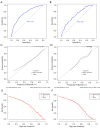The screening of optimal primary tumor resection candidates in patients with small cell lung cancer: a population-based predictive model
- PMID: 40104713
- PMCID: PMC11912087
- DOI: 10.21037/tcr-24-1419
The screening of optimal primary tumor resection candidates in patients with small cell lung cancer: a population-based predictive model
Abstract
Background: Although a strong survival benefit has been observed among small cell lung cancer (SCLC) patients undergoing surgery, not all SCLC patients benefit from surgery. To help clinicians make choices and decisions regarding surgical intervention, we have developed an effective model to screen beneficial candidates based on population and tumor characteristics.
Methods: Patients with SCLC were acquired from the Surveillance, Epidemiology, and End Results database. Propensity score matching (PSM) was performed to balance covariates between the surgery and non-surgery groups. We assumed that patients undergoing surgery between 2014 and 2018 would benefit from the procedure if their median cancer-specific survival (CSS) time was longer than that of non-surgical patients. Univariate and multivariable logistic analyses were used to identify independent factors of surgical benefit in the surgery group. According to these preoperative factors, a nomogram was built and then internal and external validation were performed.
Results: In total, 35,214 patients with complete data were included for subsequent analysis, 1,364 of whom underwent surgery. Before and after PSM, surgery was an independent factor of long-term survival, with a median CSS time of 37.00 months for the surgery group compared to 16.00 months for the non-surgery group. A multivariable logistic model identified T stage, N stage, M stage, tumor site, and age as independent factors, which were used to establish a stable predictive model.
Conclusions: We have built a preoperative predictive model for SCLC patients to screen for optimal surgery candidates. This model has the potential to help clinicians determine whether it is beneficial to operate on patients with SCLC.
Keywords: Surgical candidates; Surveillance, Epidemiology, and End Results database (SEER database); nomogram; propensity score matching (PSM); small cell lung cancer (SCLC).
Copyright © 2025 AME Publishing Company. All rights reserved.
Conflict of interest statement
Conflicts of Interest: All authors have completed the ICMJE uniform disclosure form (available at https://tcr.amegroups.com/article/view/10.21037/tcr-24-1419/coif). The authors have no conflicts of interest to declare.
Figures





Similar articles
-
Identifying optimal candidates for primary tumor resection among metastatic non-small cell lung cancer patients: a population-based predictive model.Transl Lung Cancer Res. 2021 Jan;10(1):279-291. doi: 10.21037/tlcr-20-709. Transl Lung Cancer Res. 2021. PMID: 33569312 Free PMC article.
-
Effect of pleural invasion on survival of patients with small cell lung cancer: Propensity score analysis and nomogram establishment based on the SEER database.Front Surg. 2023 Feb 23;10:1108732. doi: 10.3389/fsurg.2023.1108732. eCollection 2023. Front Surg. 2023. PMID: 36911624 Free PMC article.
-
A visualized model for identifying optimal candidates for aggressive locoregional surgical treatment in patients with bone metastases from breast cancer.Front Endocrinol (Lausanne). 2023 Oct 5;14:1266679. doi: 10.3389/fendo.2023.1266679. eCollection 2023. Front Endocrinol (Lausanne). 2023. PMID: 37867528 Free PMC article.
-
Identified optimal candidates for pulmonary resection in octogenarians with non-small cell lung cancer: a web-based predictive model.J Thorac Dis. 2023 Mar 31;15(3):1142-1154. doi: 10.21037/jtd-22-997. Epub 2023 Mar 6. J Thorac Dis. 2023. PMID: 37065566 Free PMC article.
-
Effect of surgery on survival in patients with stage III N2 small cell lung cancer: propensity score matching analysis and nomogram development and validation.World J Surg Oncol. 2021 Aug 30;19(1):258. doi: 10.1186/s12957-021-02364-6. World J Surg Oncol. 2021. PMID: 34461929 Free PMC article.
References
LinkOut - more resources
Full Text Sources
Miscellaneous
